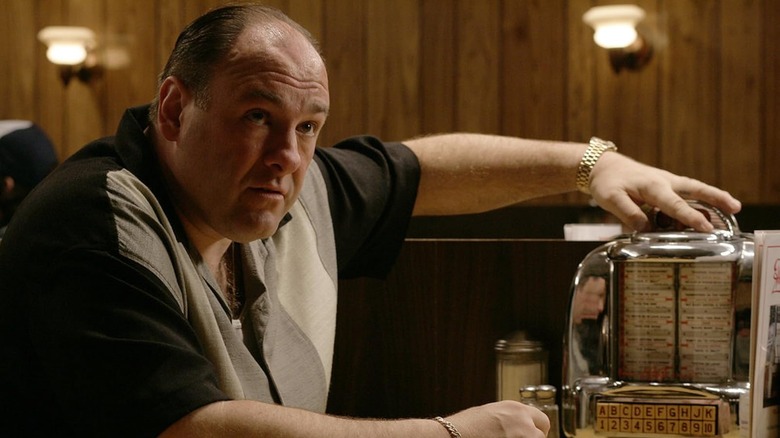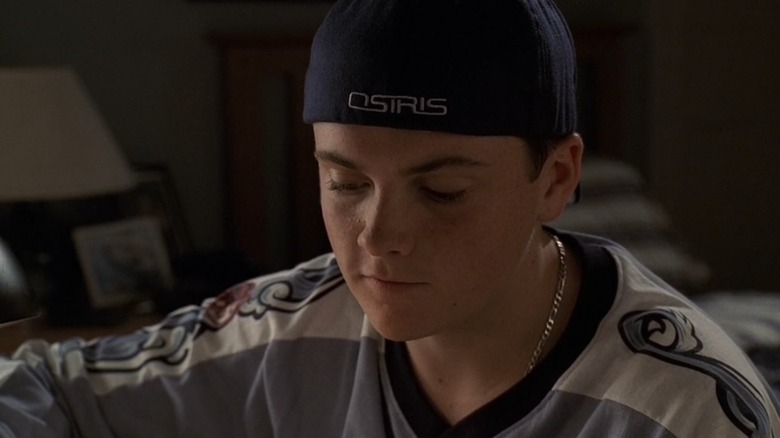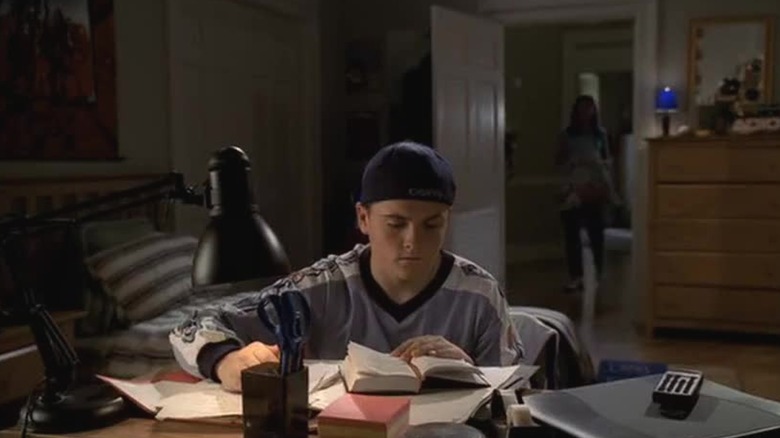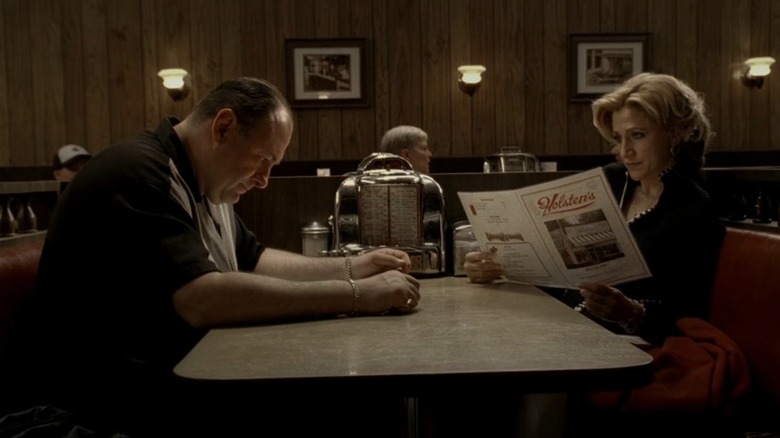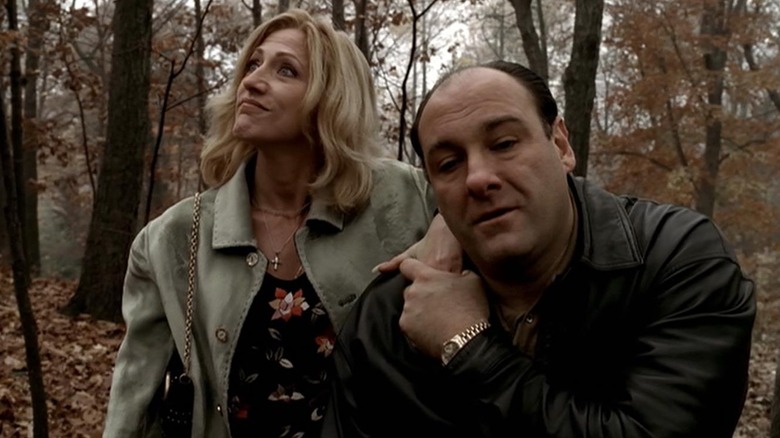David Chase Says The Key To The Sopranos Finale Is Buried In Season 3
What really happened after the cut to black at the end of "The Sopranos"? It's a question that's plagued fans of the HBO mob drama for close to two decades now, but it sometimes seems like a question without an answer. The abrupt end to Tony Soprano's story, which came as he and his family sat down for a fairly normal-seeming dinner at Holston's, was for years presented by series creator David Chase as a sort of Schrodinger's Cat situation. Either Tony (James Gandolfini) is dead, or he's not, but we can't know since we weren't given that information. The end is what it is, and all we can do is make peace with it.
But the fact that so many "Sopranos" fans naturally took the cut to black to mean Tony could've been killed must mean something, right? This interpretation wasn't random, as there were details in the finale hinting that all may not be well at this family dinner. The scene includes a suspicious-looking white guy in a Members Only jacket, as well as two Black men – often the go-to fall guys for the Italian mafia's crimes in the show, as in the episode "Unidentified Black Males" – who walk in the restaurant soon before the scene cuts off. There's also the fact that Tony, who's had a lot of people gunning for his head lately, looks up every time the bell above the door to Holston's chimes. Is he waiting for his daughter Meadow, or preparing for an attack? The end of "Made in America" is edited for maximum suspense, but leaves us before the source of the tension arrives.
An exchange in Livia Soprano's death episode was on Chase's mind at the end
In recent years, Chase has become less tight-lipped about the end of "Made In America," though even when he does let his own interpretation of the scene slip, he's often still ambiguous about what was running through his head at the time. In Alan Sepinwall and Matt Zoller Seitz's 2019 book "The Sopranos Sessions," Chase seems to describe the final scene as a "death scene," though he would later tell The Hollywood Reporter that he was thinking not of the scene that had ended up in the show, but of another idea he had, in which Tony would be killed at a meeting in New York. Now, with the new two-part HBO documentary "Wise Guy," Chase is more frank than ever about the ending, and even references a season 3 exchange that he says played into his ideas about the show's last moments.
Like so many of the best exchanges in "The Sopranos," the scene Chase mentions doesn't draw attention to its profundity, instead allowing viewers to draw their own conclusions while portraying the show's characters as inadvertently funny and more than a little stupid. The episode in question, "Proshai, Livushka," is remembered as the one in which Livia Soprano (Nancy Marchand) dies, but it also features an exchange between Meadow (Jamie Lynn-Sigler) and A.J. (Robert Iler) that Chase says was on his mind when the show ended. In it, A.J. attempts to decode his homework, Robert Frost's poem "Stopping By The Woods on a Snowy Evening," while listening to metal music. "A**hole Robert Frost!" he declares, before Meadow steps in to help.
A.J. Soprano thinks black symbolizes death
In her attempt to get A.J. to think metaphorically, Meadow asks him what snow could represent in the poem. He says "Christmas," but she's thinking of something else. "Hello? Cold? Endless white? Endless nothing!" When A.J. still doesn't get it, Meadow gives him the answer: death. "I thought black was death," A.J. responds. Meadow explains that Frost's narrator is "talking about his own death, which is yet to come but will come." Her brother simply concludes, "That's f***ed up." Still, as Meadow leaves the room, he reasserts his idea that it's the color black, not white, that symbolizes death.
At the end of the new documentary, Chase says he misses the problem-solving and writing choices that come with filmmaking, and cites the decision to end "Made in America" with the cut to black as one example. "During the editing process: well, why black? Why a cut to black?" He answers himself by referencing "Proshai, Livushka," saying, "I mean, there was that scene between Meadow and A.J. This is a long time ago. He was doing his homework. 'Woods on a Snowy Evening,' I think is the poem. Robert Frost poem. And she says-" Here, the documentary replays the scene, and Meadow's claim that white is death. "'I thought black meant death!'" Chase recalls A.J. saying. "So that was in my head, also. But, see now people will say, 'See, he admitted it!'"
Made in America asks us to imagine what's next
This does feel like an admission, but not one that lessens the impact of "Made in America." The fact that Chase, who famously has a great memory for detail, tied the potential death of Tony Soprano to his son's half-hearted misinterpretation of a poem years earlier is nothing short of genius. As relatively insignificant as that scene was at the time, it also came during the episode that saw Livia Soprano die. Given how complex Chase's relationship was with his own mother, who he tells "Wise Guy" documentarian Alex Gibney he based the character on – and built the show's world around – it's unsurprising that associations with her fictional counterpart's death would reemerge, purposefully or otherwise, in the series' final hour.
We talk a lot about whether or not Chase meant for Tony Soprano to die at the end of the show, but we don't talk enough about how haunting the part of the story that's left to our imagination is. Rewatching the final scene in light of Chase's recent vague revelations, I'm struck by heartbreaking, small details I didn't notice before. Not everyone realizes they're in the last moments of their life while they're in them, and that seems to be true for Carmela (Edie Falco), A.J., and Meadow, if not Tony. The family dinner is taken for granted to the point that Carmela barely looks at Tony in the scene, not out of any sort of malice, but just because she's so certain she'll see him again later. While A.J. is feeling thoughtful (he references Tony's request to remember the good times, another seasons-old exchange), Meadow is simply focused on parallel parking. Will she walk into a bloodbath, with her dad shot on the floor? Or did she step into Holston's right as it happened, and end up caught in the middle of the violence?
There's one (other) death scene David Chase wouldn't show us
It's hard to imagine Tony dying in front of his family in Holston's, just like it's hard to imagine any of them ending up shot in the process. Chase allows us to choose to imagine these things, or to choose not to. Another behind-the-scenes story shared in "Wise Guy," in which Chase decides to break his own rules by filming Adriana's death sequence without showing her dying, feels key to "Made in America," too. "David did not want to see her get shot, because he loved her," actress Drea de Matteo explained, and Chase seconded her: "I couldn't bear to see Adriana get shot. I couldn't have watched that." Is it possible that the same held true for Tony? In a world that often frames great art as more formal than emotional, there's something beautiful and personal about a filmmaker sparing the world a scene they wouldn't want to watch themselves.
Chase gives fans one additional clue about the end of Tony Soprano before "Wise Guys" itself cuts to black. He says that he used the Journey song "Don't Stop Believing" in the show's final scene in part because he kept coming back to a few key lyrics: "the movie never ends/It goes on and on and on and on." That cut to black was an end to one movie, so to speak, but by ending in the midst of so much everyday action, Chase reminds us that the lives of others will carry on. "I think what I was thinking about was, 'The universe goes on and on,'" he explained. "You may not go on and on, but the universe is gonna go on and on. The movie's gonna keep going." Black may mean death here, but it doesn't mean the end: we're still here, after all, still thinking about how "The Sopranos" left us all these years later. That in itself makes Tony's fate brilliant.
"Wise Guy" is now streaming on Max.
